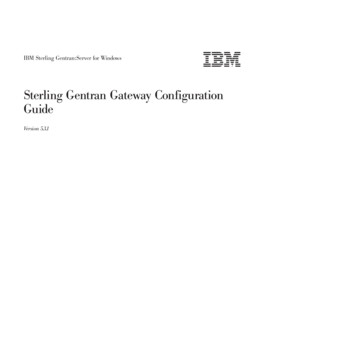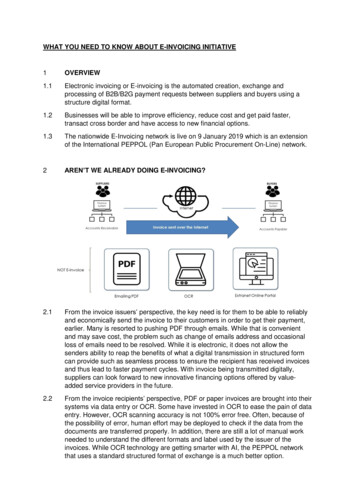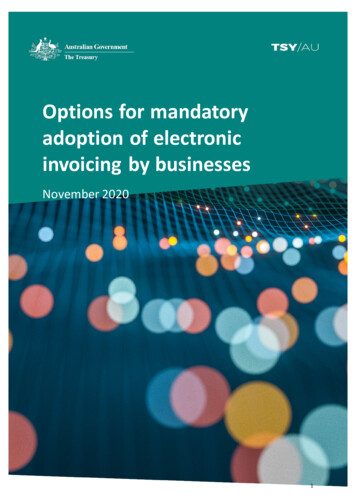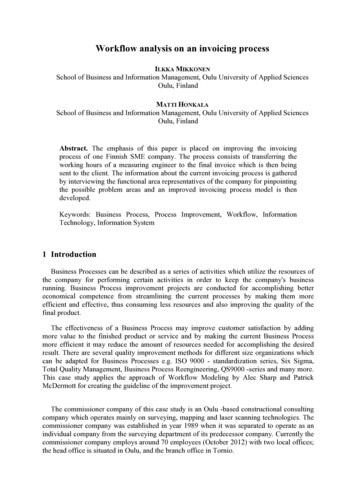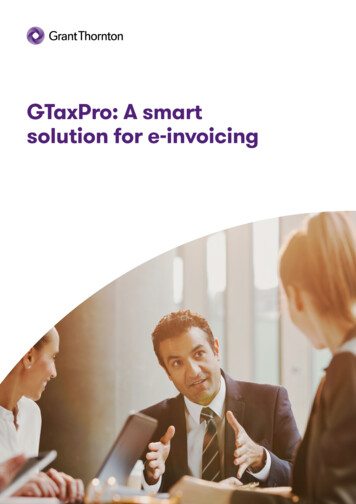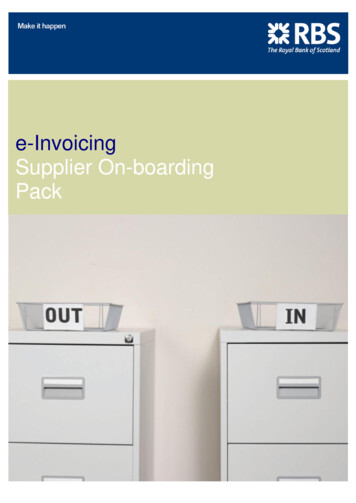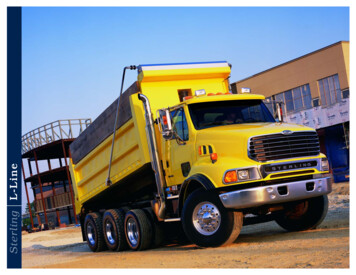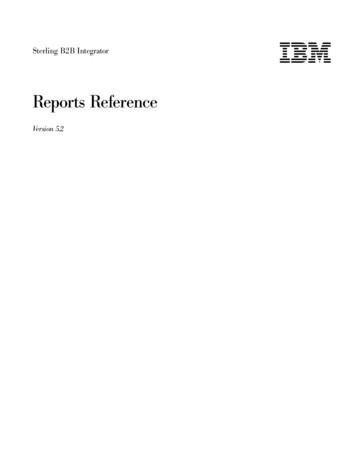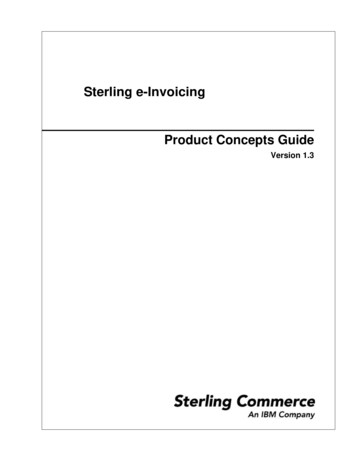
Transcription
Sterling e-InvoicingProduct Concepts GuideVersion 1.3
Licensed Materials - Property of Sterling Commerce Copyright Sterling Commerce, an IBM Company 2008, 2010 All Rights Reserved.US Government Users Restricted Rights - Use, duplication or disclosure restricted by contract with SterlingCommerceAdditional copyright information is located on the Sterling Integrator 5.1 entation/SI51/CopyrightPage.htmSterling Commerce, Inc.2
ContentsSterling e-Invoicing . . . . . . . . . . . . . . . . . . . . . . . . . . . . . . . . . . . . . . . . . . . . . . . . . . . . . . . . . . . . . . .Prerequisites . . . . . . . . . . . . . . . . . . . . . . . . . . . . . . . . . . . . . . . . . . . . . . . . . . . . . . . . . . . . . . . . .Overview . . . . . . . . . . . . . . . . . . . . . . . . . . . . . . . . . . . . . . . . . . . . . . . . . . . . . . . . . . . . . . . . . . . .Signature Verification and Invoice Validation . . . . . . . . . . . . . . . . . . . . . . . . . . . . . . . . . . . . . . . .Archive Methods . . . . . . . . . . . . . . . . . . . . . . . . . . . . . . . . . . . . . . . . . . . . . . . . . . . . . . . . . . . . . .Auditor functions . . . . . . . . . . . . . . . . . . . . . . . . . . . . . . . . . . . . . . . . . . . . . . . . . . . . . . . . . . . . . .Supplier and Buyer Processes . . . . . . . . . . . . . . . . . . . . . . . . . . . . . . . . . . . . . . . . . . . . . . . . . . .Mapping . . . . . . . . . . . . . . . . . . . . . . . . . . . . . . . . . . . . . . . . . . . . . . . . . . . . . . . . . . . . . . . . . . . .Interoperability. . . . . . . . . . . . . . . . . . . . . . . . . . . . . . . . . . . . . . . . . . . . . . . . . . . . . . . . . . . . . . . .User Permissions . . . . . . . . . . . . . . . . . . . . . . . . . . . . . . . . . . . . . . . . . . . . . . . . . . . . . . . . . . . . .Access to Sterling e-Invoicing by Tax Auditors and End Users . . . . . . . . . . . . . . . . . . . . . . . . . .Application and Sterling e-Invoicing . . . . . . . . . . . . . . . . . . . . . . . . . . . . . . . . . . . . . . . . . . . . . . .e-Invoice Buyer and Supplier Processes. . . . . . . . . . . . . . . . . . . . . . . . . . . . . . . . . . . . . . . . . . . . . . .Logical Separation of the Buyer and Supplier Processes . . . . . . . . . . . . . . . . . . . . . . . . . . . . . . .Supplier Process . . . . . . . . . . . . . . . . . . . . . . . . . . . . . . . . . . . . . . . . . . . . . . . . . . . . . . . . . . . . . .Buyer Process. . . . . . . . . . . . . . . . . . . . . . . . . . . . . . . . . . . . . . . . . . . . . . . . . . . . . . . . . . . . . . . .Sterling e-Invoicing Functionality. . . . . . . . . . . . . . . . . . . . . . . . . . . . . . . . . . . . . . . . . . . . . . . . . . . . .Canonical Invoice Format . . . . . . . . . . . . . . . . . . . . . . . . . . . . . . . . . . . . . . . . . . . . . . . . . . . . . . .Maximum Invoice Size . . . . . . . . . . . . . . . . . . . . . . . . . . . . . . . . . . . . . . . . . . . . . . . . . . . . . . . . .Limiting Invoice Size . . . . . . . . . . . . . . . . . . . . . . . . . . . . . . . . . . . . . . . . . . . . . . . . . . . . . . . .Maximum Number of Open Connections . . . . . . . . . . . . . . . . . . . . . . . . . . . . . . . . . . . . . . . . . . .Validating e-Invoices . . . . . . . . . . . . . . . . . . . . . . . . . . . . . . . . . . . . . . . . . . . . . . . . . . . . . . . . . . .Archiving e-Invoices . . . . . . . . . . . . . . . . . . . . . . . . . . . . . . . . . . . . . . . . . . . . . . . . . . . . . . . . . . .Integrated Archive . . . . . . . . . . . . . . . . . . . . . . . . . . . . . . . . . . . . . . . . . . . . . . . . . . . . . . . . .External Archive . . . . . . . . . . . . . . . . . . . . . . . . . . . . . . . . . . . . . . . . . . . . . . . . . . . . . . . . . . .Custom/Trading Partner Archive . . . . . . . . . . . . . . . . . . . . . . . . . . . . . . . . . . . . . . . . . . . . . .Integrated Archive Online Access . . . . . . . . . . . . . . . . . . . . . . . . . . . . . . . . . . . . . . . . . . . . . . . . .Integrated Archive Re-validation . . . . . . . . . . . . . . . . . . . . . . . . . . . . . . . . . . . . . . . . . . . . . .Scheduled Archive Timestamping. . . . . . . . . . . . . . . . . . . . . . . . . . . . . . . . . . . . . . . . . . . . . . . . .Archive Audit Trail . . . . . . . . . . . . . . . . . . . . . . . . . . . . . . . . . . . . . . . . . . . . . . . . . . . . . . . . . . . . .Agreements . . . . . . . . . . . . . . . . . . . . . . . . . . . . . . . . . . . . . . . . . . . . . . . . . . . . . . . . . . . . . . . . . . . . .TrustWeaver Error Handling . . . . . . . . . . . . . . . . . . . . . . . . . . . . . . . . . . . . . . . . . . . . . . . . . . . . . . . .Supplier Process Error Scenarios . . . . . . . . . . . . . . . . . . . . . . . . . . . . . . . . . . . . . . . . . . . . . . . . .Buyer Process Error Scenarios. . . . . . . . . . . . . . . . . . . . . . . . . . . . . . . . . . . . . . . . . . . . . . . . . . .Error Handling . . . . . . . . . . . . . . . . . . . . . . . . . . . . . . . . . . . . . . . . . . . . . . . . . . . . . . . . . . . . . . . .Workflow Scenarios. . . . . . . . . . . . . . . . . . . . . . . . . . . . . . . . . . . . . . . . . . . . . . . . . . . . . . . . . . . . . . .Introduction . . . . . . . . . . . . . . . . . . . . . . . . . . . . . . . . . . . . . . . . . . . . . . . . . . . . . . . . . . . . . . . . . .Scenario 1 . . . . . . . . . . . . . . . . . . . . . . . . . . . . . . . . . . . . . . . . . . . . . . . . . . . . . . . . . . . . . . . . . . .Scenario 2 . . . . . . . . . . . . . . . . . . . . . . . . . . . . . . . . . . . . . . . . . . . . . . . . . . . . . . . . . . . . . . . . . . .Sterling Commerce, 181920202121232323253
ContentsScenario 3 . . . . . . . . . . . . . . . . . . . . . . . . . . . . . . . . . . . . . . . . . . . . . . . . . . . . . . . . . . . . . . . . . . .Scenario 4 . . . . . . . . . . . . . . . . . . . . . . . . . . . . . . . . . . . . . . . . . . . . . . . . . . . . . . . . . . . . . . . . . . .Scenario 5 . . . . . . . . . . . . . . . . . . . . . . . . . . . . . . . . . . . . . . . . . . . . . . . . . . . . . . . . . . . . . . . . . . .Scenario 6 . . . . . . . . . . . . . . . . . . . . . . . . . . . . . . . . . . . . . . . . . . . . . . . . . . . . . . . . . . . . . . . . . . .Scenario 7 . . . . . . . . . . . . . . . . . . . . . . . . . . . . . . . . . . . . . . . . . . . . . . . . . . . . . . . . . . . . . . . . . . .Scenario 8 . . . . . . . . . . . . . . . . . . . . . . . . . . . . . . . . . . . . . . . . . . . . . . . . . . . . . . . . . . . . . . . . . . .Glossary . . . . . . . . . . . . . . . . . . . . . . . . . . . . . . . . . . . . . . . . . . . . . . . . . . . . . . . . . . . . . . . . . . . . . . .Sterling Commerce, Inc.262830313335374
Sterling e-InvoicingElectronic invoicing (e-Invoicing) allows you to eliminate the paper trail that companies must maintain tocomply with Value Added Tax (VAT) laws. Compared with Electronic Data Interchange (EDI), e-Invoicingnot only facilitates the actual invoice transaction but also the audit requirements from a tax perspective.Thus, you do not need to maintain a paper record of invoices for tax purposes. Sterling e-Invoicing givesyou the benefits of electronic invoicing while also being compliant with these tax laws. Sterling e-Invoicingalso indirectly interoperates with providers of non-TrustWeaver e-Invoice solutions. These otherproviders may act as a supplier or a buyer. Sterling e-Invoicing does not connect to these providers directly,but accepts the invoices they send, and sends them in an acceptable format.This document describes the product concepts for Sterling e-Invoicing.PrerequisitesThe following are prerequisites for using Sterling e-Invoicing: The audience using this software should be familiar with the application, e-Invoicing, TrustWeaver,and Value Added Tax (VAT) compliance regulations.Note: This documentation is not intended to explain e-Invoicing or how to use TrustWeaver software. You must have purchased an e-Invoicing license for use with the application.OverviewSterling e-Invoicing uses the e-signature method of compliance. This is the digital signature approach inwhich the invoices are digitally signed by the seller using keys approved by the government of that country,and then the signature is verified by the buyer. Future audits can be verified for their authenticity andintegrity by re-verifying the signatures on the archived invoices. The e-signature method of compliance isthe preferred option of the tax authorities. It is a technical solution and it provides an unequivocal technicalguarantee of the authenticity and integrity of the invoice.Sterling e-Invoicing provides the following: A supplier process, supporting invoice validation and signing. A buyer process, supporting signature verification and invoice validation. An archive of the invoice functions enable a customer or a tax auditor to search, view, and report oninvoices and also to re-verify the signature on those invoices in the event of an audit. Timestamping facility for archived invoices having country code IT (Italy), which is used in the audittrail of an invoice. Mapping functionality that enables you to translate the invoice from any supported EDI format to thecanonical invoice format.Sterling Commerce has partnered with TrustWeaver to provide e-signature signing and verification throughits on-demand service. TrustWeaver offers products and on-demand services that support all of thenecessary hardware and certificate authorities.Sterling Commerce, Inc.5
Sterling e-InvoicingSignature Verification and Invoice ValidationSignature verification is performed through the TrustWeaver on-demand service. The EU-115 directivestates that e-Invoices should contain certain items of information that are necessary for tax purposes.Sterling e-Invoicing ensures that invoices contain the mandatory data to be compliant. This informationincludes the invoice number, date, supplier VAT ID, Buyer VAT ID, currency, and line item details(description, quantity, price, and VAT amount).Validation is achieved by mapping the invoice received from a customer to a canonical invoice format inwhich the fields that are mandatory are checked against the canonical format.Note: Canonical format is a format for storing hierarchical names that displays the hierarchical attribute ofeach component of the name.Customers must provide a map with their invoice format so that it can be translated to the publishedcanonical format. The canonical version of the invoice is also used by the invoice archive functionality toextract the necessary business content from the archive to support a human-readable view format and reportsfor the invoice.Archive MethodsSterling e-Invoicing supports three methods of archiving invoices: Integrated archive: In this method, invoices are stored in a database that is managed by Sterlinge-Invoicing and the archive is managed automatically. Also, Sterling e-Invoicing provides a userinterface to support viewing the archive data. External archive: In this method, the customer uses Sterling e-Invoicing to sign and verify invoices,but the customer archives the invoices by storing the data to enable the tax auditors to review it in thefuture. Custom/Trading partner archive: In this method, invoices are signed or verified by TrustWeaversoftware on behalf of a trading partner but not archived on their behalf. If you choose to send this datato your trading partners, Sterling e-Invoicing gives you the ability to send the necessary data to yourtrading partners so that they can archive it.Typically, an installation of Sterling e-Invoicing uses either the integrated archive or the external archivefor invoices that are being stored by the host of Sterling e-Invoicing. The installation may also use thetrading partner archive for some of the trading partners regardless of the archiving solution chosen. You canuse a combination of integrated archive and trading partner archive or external archive and trading partnerarchive.Auditor functionsAuditor functions can be used by both the staff within your company and by tax auditors. The auditfunctions enable you to search for invoices and perform the following actions: View a human readable representation of the invoice. View or download original signed invoice data. View or download invoice verification details. Create and download human-readable invoice summary and detail reports.Sterling Commerce, Inc.6
Sterling e-Invoicing Re-validate invoices and view or download the re-validation report.Re-validation of invoices will invoke the TrustWeaver Request service. Since the archive may contain datafor more than one legal entity, access to the invoice data in the archive is restricted based on permissions.Permissions control the following: Legal entities that a user may access. Functions that a user can perform on the invoices.If a tax auditor needs to access data using Sterling e-Invoicing, the tax auditor is assigned the necessarypermissions to access only the integrated archive and not any other functionality in the application.Supplier and Buyer ProcessesThe supplier and buyer processes that manage the flow of invoices through the entire e-Invoicing processare provided when Sterling e-Invoicing is installed, and require no user modification. These processes: Implement the necessary legal separation required for supplier and buyer e-Invoice processing so thatthe supplier-side processing is distinct from buyer-side processing. Perform the signing, verification, validation, and archiving of invoices.You configure the processing options for the supplier and buyer using e-Invoicing agreements that are: Configurable objects that relate two organizations involved in an electronic invoice transaction andstore the relationship options. Versioned, importable, and exportable like other application resources.MappingMapping functionality enables you to translate an invoice from any supported EDI format to the canonicalinvoice format. Some of the parameters in the canonical format are mandatory for the validation of theinvoices and if these parameters are not present in your invoice, the translation fails.Note: We provide you with a sample map (X12 810 To Canonical.mxl). This map is located in the MapEditor Install Dir /Samples/maps directory. You can use this map as an example to create yourmap for converting your invoice format to the canonical format.InteroperabilitySterling e-Invoicing interoperates indirectly with providers of non-TrustWeaver e-Invoice solutions. Theseother providers may act as a supplier or a buyer. Sterling e-Invoicing does not connect to these providersdirectly, but accepts the invoices received, and send invoices in an acceptable format.User PermissionsSterling e-Invoicing provides user permissions that can be assigned as necessary, so that you can access theuser interface and perform different operations based on the permissions assigned to you.These user permissions ensure the security of the data, and separate the data into supplier and buyer sets.Sterling Commerce, Inc.7
Sterling e-InvoicingThe e-Invoicing-specific permissions enable users to: View invoices Re-validate invoices Download invoices Create and edit agreements Perform operations on behalf of all legal entities Perform operations on behalf of a specific legal entity (requires separate permission to be set up perentity, by the operator of all the entities)Note: To perform an operation on behalf of a buyer or a supplier, the VAT ID of the buyer or the suppliermust be used to create this permission.Each operation performed through the user interface requires the appropriate permission to be assignedbefore carrying out its operation. You are notified on-screen of a failed operation if this notification is setup in the application.Access to Sterling e-Invoicing by Tax Auditors and End UsersSterling e-Invoicing provides you with a user interface from which you can perform various functions, suchas searching, downloading, viewing, reporting on, and re-validating invoices. The display of the userinterface depends on the permissions assigned to you. For example, for a tax auditor, the user interfacedisplayed depends on permissions that have been assigned to the tax auditor login. If the tax auditor is onlyrequired to audit the supplier process, then only the supplier process reports can be downloaded and viewed.The same rule applies to the buyer process. The tax auditors may download a human-readable format of theinvoices that contains the raw invoice, detail information, and audit trail. The user can download the invoicesummary report, the human-readable format, re-validate invoices, and download invoice details. End userscan edit the following types of information if they have the appropriate permissions assigned to theiraccount: Agreements Partner relationships Maps Connection to TrustWeaver Global e-Invoice ConfigurationSterling Commerce, Inc.8
Sterling e-InvoicingApplication and Sterling e-InvoicingThe following table briefly describes the components used by Sterling e-Invoicing and their functionality:FunctionalityDetailsServices eInvoice Agreement Lookup service is used to find an e-Invoice agreement. The eInvoice Archive Status Update service updates the operational status of aninvoice to either Failed or Info if the invoice is stored in the archive. It also adds adescription explaining why the status was updated. eInvoice Duplicate Check service checks the e-Invoicing internal archive databasefor duplicate invoices. When checking the duplicate invoices, the TransactionRegister is checked first for the duplicates, and then the archive database is checked. eInvoice Event service is responsible for sending e-mail notifications to the buyer orsupplier and to Sterling e-Invoicing administrator in case of any failures during thebusiness process execution. eInvoice Time Stamping Request service, when invoked, searches for all the invoicesthat have a supplier or buyer VAT ID as IT (Italy) and that are not yet timestamped. TrustWeaver Request service is used to construct a SOAP request to be sent to theTrustWeaver e-Invoice server for the purpose of signing, validating, timestamping, orre-validating an invoice. TrustWeaver Response service is used to parse the TrustWeaver e-Invoice ServerResponse sent using HTTP. Semaphore service limits the number of open connections that can be establishedwith the TrustWeaver server.Predefined businessprocessSterling Commerce, Inc.eInvoice Archive service is responsible for archiving e-Invoices. Based on the type ofarchive selected, this service either archives electronic invoices in a canonical formatto a database or provides the archive information to an external system through abusiness process.To help you accomplish your business goals, Sterling e-Invoicing provides predefinedbusiness processes. These predefined business processes are initiated by servicesduring e-Invoice processing and do not require you to modify them. They are: eInvoiceRevalidation enables the validation of the e-Invoice. eInvoiceBuyerProcess enables validation of the signed invoices, translation ofinvoice into canonical format, and archival of invoices. eInvoiceProcess does an agreement lookup and invokes the supplier and/or buyerprocess depending on the values in the agreements. eInvoiceSupplierProcess enables the signing of the invoices, translation of invoiceinto canonical format, and archival of invoices. TrustWeaverEInvoicing creates the SOAP request and sends it to the TrustWeaverserver and gets the SOAP response from the TrustWeaver server.EinvoiceTimeStamping searches for the invoices having the country code IT (Italy)and that are yet to be timestamped. It then performs the timestamping of the invoices.9
Sterling e-InvoicingFunctionalityDetailsMap Editor Map Editor wizard enables you to generate a file layout using the EDI format that youselect. Properties dialog boxes that enable you to define and modify the map components. Additional mapping operations as needed.Sterling Commerce, Inc.Autolink function automatically creates links between input and output fields thathave the same name or business name.10
e-Invoice Buyer and Supplier ProcessesWhen Sterling e-Invoicing processes an invoice, which begins when the eInvoiceProcess business processis invoked. The eInvoiceProcess looks up the agreement between the buyer and supplier to determine therequired processing options. If supplier processing is enabled, the eInvoiceProcess invokes the supplierprocess, which sends the unsigned invoice to the TrustWeaver server to be signed. If buyer processing isenabled, the eInvoiceProcess invokes the buyer process, which sends the signed invoice to the TrustWeaverserver to be validated. If both supplier and buyer processes are enabled, the eInvoiceProcess invokes thesupplier process first and then the buyer process. Archiving is performed for the signed invoice on thesupplier side, and the validated invoice on the buyer side. The archive also contains the detailed informationof the invoice, which includes the policies used while signing or validating the invoice.Logical Separation of the Buyer and Supplier ProcessesThere is a legal requirement that the supplier and buyer processes are separate. Sterling e-Invoicing inboundand outbound process flows separate the buyer and supplier processes in the following manner:1. If both the buyer and the supplier processes are executed at the same time based on the configurationsin the agreements, no part of the process flow can be skipped. The supplier process is executed in fullto sign the invoice, and the buyer process is executed in full to validate the signed invoice.2. The actual buyer and supplier processes are implemented as distinctly separate business processes.These business processes are run in an identical manner regardless of whether both the buyer and thesupplier processes are being executed or just one of the processes.3. The buyer and supplier processes communicate with the TrustWeaver server to perform the signingand validation of the invoices. TrustWeaver does the signing and validation process using separatemachines (either virtual or physical), and those machines are always managed by separate groups ofpeople.4. From a tax auditor perspective, the user interface allows the archived invoices to be viewed for onlythe supplier side, or only the buyer side, thus maintaining the separation. The necessary userpermissions are assigned so that the tax auditor can view only the specified invoices.Supplier ProcessThe Supplier Process involves signing the invoice. This process is invoked by the same eInvoiceProcessbusiness process that invokes the buyer process. The supplier process sends the invoices to TrustWeaverserver using the TrustWeaver Request service and the HTTP service protocol to sign the invoices. TheTrustWeaver Request service creates the invoice document in a SOAP format out of the raw invoice and theHTTP service protocol sends the document for signing by establishing a connection with the TrustWeaverserver. Once the document is signed, it is passed through the TrustWeaver Response service to get a rawinvoice out of the SOAP format and separate the signature from it. The supplier process also supportstranslation of the invoice into canonical format, and archiving of invoices (or packaging of the invoices tothe supplier archiving system, if using a third-party archiving system).Sterling Commerce, Inc.11
e-Invoice Buyer and Supplier ProcessesThe SupplierProcess business process needs the following inputs: PrimaryDocument, which is the raw invoice to be processed. Agreement information in ProcessData set by the Agreement Lookup service.The output of this business process is the signed invoice, while logging of the event and archiving is donein the execution of the process. This business process does not invoke another business process to do furtherprocessing, because it will be done by the eInvoiceProcess.The basic flow implemented for this business process is as follows:1. Invokes the TrustWeaver signing process synchronously. In case of errors, the TrustWeaver businessprocess logs the event and sends e-mail notifications. If errors occur at this stage, further processing isstopped.2. Invokes the Translation service to translate the invoice to canonical format, using the map informationprovided by the eInvoice Agreement Lookup service. If an error occurs at this stage, the eInvoiceEvent service is invoked to send e-mail notifications and log the errors. The process is stopped.3. Invokes the eInvoice Archive service.4. Invokes the external or custom/trading partner archive process if configured.Errors are generated if any of the following scenarios occur: Agreement object is invalid or not found by the eInvoice Agreement Lookup service Failure in signing of the e-Invoice by the TrustWeaver server Failure in translation to canonical format Duplicate invoice number detected Failure to archive Failure while writing archived data to disk (if archiving fails, or if a third-party archive is used)Buyer ProcessThe buyer process supports the buyer-side e-Invoicing flow, including invoice validation, translation of theinvoice into canonical format, and archiving of invoices.1. The buyer process sends the invoices to TrustWeaver server using the TrustWeaver Request serviceand the HTTP service protocol to validate the invoices.2. The TrustWeaver Request service creates the invoice document in a Simple Object Access Protocol(SOAP) format out of the raw invoice and the HTTP service protocol, and sends the document byestablishing a connection with the TrustWeaver server.3. Once the document is validated, it is passed through the TrustWeaver Response service to obtain a rawinvoice in the SOAP format and separate the signature from it.There is no configuration user interface for the buyer process. It is based on the VAT IDs or Lookup IDs (aswell as the message type, that allows you to specify the type of message exchanged if you have multipleagreements with the same supplier/buyer information but use different message types) of the sending andreceiving trading partners configured in the agreements.Sterling Commerce, Inc.12
e-Invoice Buyer and Supplier ProcessesThe basic flow for the BuyerProcess business process is as follows:1. It needs the following inputs: PrimaryDocument with the signed invoice to be processed. Agreement information in ProcessData set by the Agreement Lookup service.2. Invokes the TrustWeaver validation process synchronously. In case of errors, the TrustWeaverbusiness process logs the event and sends e-mail notifications. If errors occur at this stage, furtherprocessing is stopped.3. Invokes the Translation service to translate the invoice to canonical format, using the map informationprovided by the eInvoice Agreement Lookup service from step 1. If an error occurs at this stage, theeInvoice Event service is invoked to send e-mail notifications and log the errors. The process isstopped.4. Invokes the eInvoice Archive service.5. Invokes the external or custom archive process, if configured.To ensure proper processing based on the service level agreement (SLA), the eInvoiceProcess has toperform different functions. The basic flow implemented for this business process is as follows:1. The eInvoiceProcess needs the following inputs: PrimaryDocument with the invoice to be processed (raw or signed depending upon theconfiguration). SupplierVAT, which is the ProcessData parameter that indicates the Supplier VAT ID. BuyerVAT, which is the ProcessData parameter that indicates the Buyer VAT ID. Lookup IDs, which is configured for each entity as an alternative lookup field to the VAT ID.Requires either SupplierVAT and BuyerVAT or SupplierLookupID and BuyerLookupID. Message-Type, which is required if there are multiple agreements set up for the same pair ofentities for different message types.2. Invokes the eInvoice Agreement Lookup service to populate ProcessData with all the specifiedagreement information (canonical format translation map, error notification e-mail, and so on). In caseof errors, the eInvoice Event service is invoked to log the event, send e-mail notifications, andprocessing is halted.3. Invokes the supplier process, buyer process, or both depending upon agreement configuration. Anyerrors occurring during the execution of these processes are already handled, so the processing isstopped.4. Invokes the normal post-processing business process, if configured in the agreement.Errors are generated in the following scenarios: Agreement object is invalid or not found by the eInvoice Agreement Lookup service Failure in the validation of the e-Invoice by TrustWeaver Failure in translation to canonical format Duplicate invoice number detected Failure to archiveSterling Commerce, Inc.13
e-Invoice Buyer and Supplier Processes Failure while writing archived data to disk (if archiving fails, or if a third-party archive is used)Sterling Commerce, Inc.14
Sterling e-Invoicing FunctionalitySterling e-Invoicing enables you to send a signed or unsigned electronic invoice to your trading partner. Itenables your trading partner to send the invoice to TrustWeaver to sign if the invoice is not signed already,or to validate if the invoice is signed. The signed and validated invoice is archived for future auditing byyour company and tax auditors. If you wish to archive the invoices in your own database then you need touse the external archive functionality. The internal archives can be used for: Searching specific invoices. Re-validating invoices. Invoice re-validation invokes TrustWeaver. Viewing a hum
Integrated archive: In this method, invoices are stored in a database that is managed by Sterling e-Invoicing and the archive is managed automatically. Also, Sterling e-Invoicing provides a user interface to support viewing the archive data. External archive: In this method, the customer uses Sterling e-Invoicing to sign and verify invoices,
